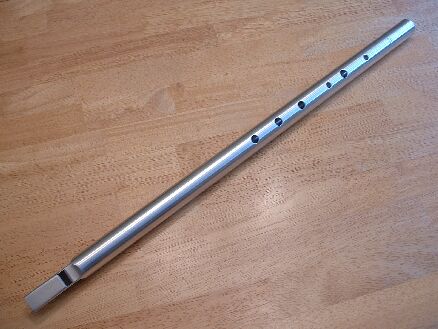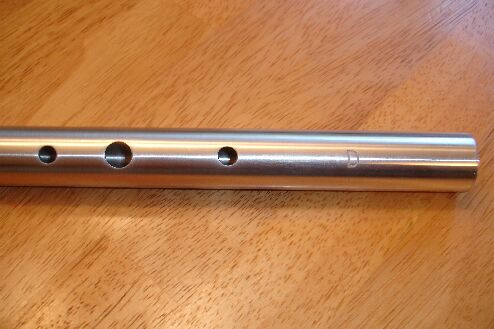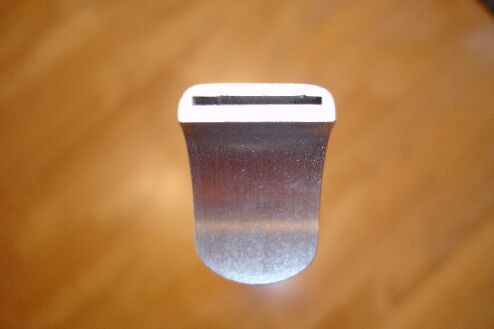Maker - Overton (Bernard Overton) www.overton.de
Material - Aluminum
Dimensions: Length - 23 2/8ths"
Distance between 1st and 3rd bottom holes - 2 6/8ths"
Diameter of 2nd hole from bottom - 3/8ths"
Bore - 7/8ths"
Weight - 7 oz
Price at time of review - 185 euros direct from Maker, 140.00 lbs from distributor
I
purchased this whistle used via the Chiff and Fipple forum. I was
excited to finally own not only an original Overton Low D (the whistle
that all other low D's have sprung from), but also one made by the
father of low whistles, Bernard Overton (see History
section). This particular model is called the "short reach" Low D, as
the bottom three holes have been moved closer together for ease of
playing. It came with a certificate of authenticity signed by the man
himself, and a nice cloth bag with velcro closure.






Appearance:While
some would say it just looks like a metal tube with holes in it, I find
that there is something aesthetically appealing about the simplicity of
its construction. I think it has a very zen feel to it.
Tone: Some astute whistler, or perhaps a poet who will live forever in infamy, came up with the perfect descriptor for the distinctive tone of Overton whistles, calling it the "Cosmic Drainpipe" sound. This of course is one of those phrases that only makes sense after you've actually heard one, making it somewhat limited in usefulness when trying to describe the sound to someone who hasn't (Of course once you have heard one, you will realize that cosmic drainpipe is the perfect moniker!)
The second octave of this particular whistle is very pure and sweet in tone, and does manage to avoid being overly shrill, with the possible exception of the high B note. The bottom octave has more of a breathy (but not overly so) and sonically turbulent. The whole range has a pretty significant amount of chiff. The low fundamental note is pleasingly full, but does break somewhat easily. The second note (E) is also much weaker and breathier in tone, especially when compared to the other notes. This whistle sounds best when fully warmed up, which is generally true of most aluminum whistles. Unfortunately, it is hard to keep warmed up, and can take some time and effort to get it warm initially.
Volume: I would describe the volume of this whistle as being medium-loud in comparison to other Low D's I have played. It is not particularly well balanced, as the second octave is fairly loud while the first octave would be lost in most session environments.
Backpressure/air requirement: Overtons are known for having a decent amount of backpressure and this whistle is no exception, as it has moderate (although I certainly wouldn't say high) backpressure. This slightly decreases the amount of air require to play it in comparison to other low D's. As mentioned under tone, the second note (E) is weak, and breaks very, very easily. One needs to back off considerably breath wise in comparison to other notes. Even the low fundamental note under it allows for more breath. I would note that a standard Overton Low D that I had played previously did not have this issue.
Responsiveness: As mentioned, I had played a regular/standard Overton Low D before, which I found to be quite responsive. So I was surprised to find that this whistle could be a bit sluggish when performing ornaments. This whistle is also very touchy and unforgiving, and will squawk most unpleasantly if your fingering is not spot on. Nor would it let me bend or slowly slide notes in the second octave without squawking either. The first and the third holes on the whistle seem much smaller in comparison to other low D's, indeed they look like the belong on a high D whistle. I am not certain (as I am definitely Not a whistle maker), but I think this may be due to moving them closer together to decrease the finger stretch. Unfortunately, a negative side effect of this is that finger vibrato just doesn't seem to work or sound good due to these smaller holes.
Clogging: I did not experience any clogging issues with this whistle once it was warmed up, but it would occasionally clog if I tried to blow the whistle when it was cold.
Tuning: This first octave of this whistle is pretty spot on tuning wise, but in the second octave from the F# on up, it tends to hang around 20 cents flat. Now you can of course compensate by blowing harder, but this just makes the volume discrepancy between the octaves even more evident, and can make the higher notes start to sound screechy. The C natural is just slightly flat using the standard OXXOOO fingering. This can be corrected by dropping your third finger (OXXXOO), but the difference is so slight I personally don't think it is necessary. (On a side note, the low E sounded so weak and odd, that my tuner couldn't even identify the pitch!)
Sound clip: Si beag Si Mor
Summary: Having high expectations, I have to admit that in the end I was quite disappointed with this whistle. While it did deliver on the distinctive Overton sound, issues with responsiveness and the low E note force me to give this whistle only three and a half holes. I doubt I will keep it in my collection. I definitely want to note however that this specific whistle is not typical of my experience with other Overton brand whistles.

Tone: Some astute whistler, or perhaps a poet who will live forever in infamy, came up with the perfect descriptor for the distinctive tone of Overton whistles, calling it the "Cosmic Drainpipe" sound. This of course is one of those phrases that only makes sense after you've actually heard one, making it somewhat limited in usefulness when trying to describe the sound to someone who hasn't (Of course once you have heard one, you will realize that cosmic drainpipe is the perfect moniker!)
The second octave of this particular whistle is very pure and sweet in tone, and does manage to avoid being overly shrill, with the possible exception of the high B note. The bottom octave has more of a breathy (but not overly so) and sonically turbulent. The whole range has a pretty significant amount of chiff. The low fundamental note is pleasingly full, but does break somewhat easily. The second note (E) is also much weaker and breathier in tone, especially when compared to the other notes. This whistle sounds best when fully warmed up, which is generally true of most aluminum whistles. Unfortunately, it is hard to keep warmed up, and can take some time and effort to get it warm initially.
Volume: I would describe the volume of this whistle as being medium-loud in comparison to other Low D's I have played. It is not particularly well balanced, as the second octave is fairly loud while the first octave would be lost in most session environments.
Backpressure/air requirement: Overtons are known for having a decent amount of backpressure and this whistle is no exception, as it has moderate (although I certainly wouldn't say high) backpressure. This slightly decreases the amount of air require to play it in comparison to other low D's. As mentioned under tone, the second note (E) is weak, and breaks very, very easily. One needs to back off considerably breath wise in comparison to other notes. Even the low fundamental note under it allows for more breath. I would note that a standard Overton Low D that I had played previously did not have this issue.
Responsiveness: As mentioned, I had played a regular/standard Overton Low D before, which I found to be quite responsive. So I was surprised to find that this whistle could be a bit sluggish when performing ornaments. This whistle is also very touchy and unforgiving, and will squawk most unpleasantly if your fingering is not spot on. Nor would it let me bend or slowly slide notes in the second octave without squawking either. The first and the third holes on the whistle seem much smaller in comparison to other low D's, indeed they look like the belong on a high D whistle. I am not certain (as I am definitely Not a whistle maker), but I think this may be due to moving them closer together to decrease the finger stretch. Unfortunately, a negative side effect of this is that finger vibrato just doesn't seem to work or sound good due to these smaller holes.
Clogging: I did not experience any clogging issues with this whistle once it was warmed up, but it would occasionally clog if I tried to blow the whistle when it was cold.
Tuning: This first octave of this whistle is pretty spot on tuning wise, but in the second octave from the F# on up, it tends to hang around 20 cents flat. Now you can of course compensate by blowing harder, but this just makes the volume discrepancy between the octaves even more evident, and can make the higher notes start to sound screechy. The C natural is just slightly flat using the standard OXXOOO fingering. This can be corrected by dropping your third finger (OXXXOO), but the difference is so slight I personally don't think it is necessary. (On a side note, the low E sounded so weak and odd, that my tuner couldn't even identify the pitch!)
Sound clip: Si beag Si Mor
Summary: Having high expectations, I have to admit that in the end I was quite disappointed with this whistle. While it did deliver on the distinctive Overton sound, issues with responsiveness and the low E note force me to give this whistle only three and a half holes. I doubt I will keep it in my collection. I definitely want to note however that this specific whistle is not typical of my experience with other Overton brand whistles.